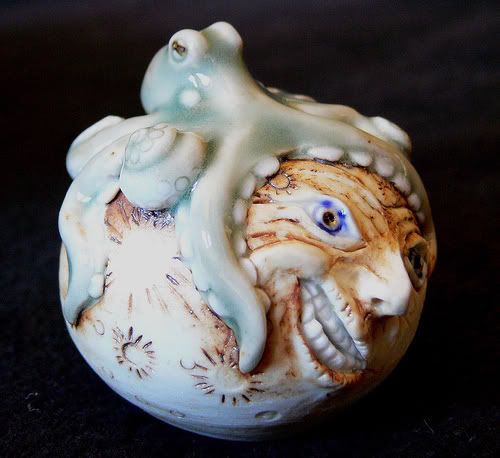Arte y pulpos -Octopus netsuke- Okimono
Published Sunday, August 07, 2005 by Spyder | E-mail this postEl okimono es una talla que suele ser de marfil más grande que el netsuke. El netsuke es más conocido porque tiene todo un mercado de coleccionistas detrás de ellos, pero el okimono al tener un mercado mucho más reducido no tiene demasiada presencia en internet.

Vía locamotion
A mí esta escultura me recuerda mucho a la imagen de George Meliès de la luna con el cohete en el ojo (El viaje a la Luna), pero en vez de estar malhumorada, ésta en cambio parece divertirse de tener un pulpo correteando por su superficie. De todas maneras no sé si tiene algún significado especial. Seguiré investigando.

Vía locamotion
A mí esta escultura me recuerda mucho a la imagen de George Meliès de la luna con el cohete en el ojo (El viaje a la Luna), pero en vez de estar malhumorada, ésta en cambio parece divertirse de tener un pulpo correteando por su superficie. De todas maneras no sé si tiene algún significado especial. Seguiré investigando.
Okimono
Vía galería Kitsunegaroo
When talking about miniature sculptures, the first object that comes to our mind is the netsuke. Okimono, the larger ornamental carvings, are much less popular. They were made as ornaments for the tokonoma. Like netsuke, they represent Japanese habits and mythology. Buddhist idols and Noh masks inspired many artists when creating these miniature sculptures. They were made out of wood and ivory and very often sculptured by netsuke carvers during the Meiji period. Wood was the only material employed during different centuries both in temples and Japanese housing. Around the 18th century the use of ivory increased. At the beginning of this century, the samisen (a stringed instrument) music became very popular. The plectrum to play this instrument was made out of the centre part of the tusk of an elephant. The small pieces that were left over were ideal for the carving of netsuke and, at a later stage, okimono. The Westernisation brought far-reaching changes to Japan. Artists had to adapt their concepts to the demand of the Western world. As a result of the influence from the West, pockets were now added to the Japanese kimono, eliminating the need for netsuke. During the Meiji period netsuke were still produced for collectors, but more and more netsuke carvers began to focus on okimono. Because of the great demand for okimono for export, many artists started to produce objects of an inferior quality. However, there were also carvers that created beautifully sculptured okimono and followed the traditional high standard of their craft. The classification of wood and ivory okimono can be done by school (such as Kyoto or Tokyo schools), but the merit of each object leads to two trends in okimono carving that make the classification more adequate. The first one sticks to the Japanese tradition and can be recognized by strong modelling with striking poses, flowing lines and strongly expressed emotions. Traces of round and flat chisel marks can be found on some of these okimono. For the Japanese art lovers these chisel marks have the same appeal as the brush strokes in painting. The demand from the West leads to the second trend where good craftsmanship was characterised by a smooth surface without chisel marks.



0 Responses to “Arte y pulpos -Octopus netsuke- Okimono”
Leave a Reply